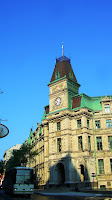 |
| Photo by Bo. W |
 |
| Photo by Bo. W |
Rue Saint-Jean
One end of Saint-Jean Street is a gate - Porte
Saint-Jean, which is located where D 'Youville. It is at the junction of the
new and the old Quebec. While the other end of the Rue Saint-Jean Street in the
Place de l'Hôtel-de-Ville Park. The whole street Rue Saint-Jean has many
historic buildings, they are painters, photographers, tourists in the eyes of
the target.
 |
| Photo by Bo. W |
Place de Paris is the first French people who settled
in Quebec City, there is a black and white sculpture, it is a controversial
avant-garde artist Matthew Raynault work. Entitled "Dialogue with
History" with two blocks of marble tile, it said across the history of the
galaxy. It is a gift from France in 1987.
 |
| Photo by Bo. W |
Séminaire de Québec -- hidden treasures
Séminaire de Quebec (French: Séminaire de Québec) was
founded in 1663, it is Canada's oldest educational institutions. The Seminary
of Quebec (French: Séminaire de Québec) is a Roman Catholic community of
priests in Quebec City founded by Bishop François de Laval, the first bishop of
New France in 1663. The Seminary of Quebec (French: Séminaire
de Québec), it has a private French-language Roman Catholic secondary school,
seminaries and clergy. Many French-Canadian clergy of the 18th and 19th
century, as well as innumerable academics, went through
the Petit Séminaire
before higher education became widely accessible.
 |
| Photo by Bo. W |
Now, since 1987 Petit Seminaire de Québec is a private
Roman Catholic secondary school separated from the Séminaire de Québec. Until
1970, Séminaire de Québec has become Laval University, which was originally a
branch of Séminaire de Québec institutions. This remarkable architectural
complex is designated as a National Historic Site of Canada in 1929.
 |
| Photo by Bo. W |
Statue of François-Xavier de Montmorency-Laval
standing in front of the Bureau de Poste building in Old Quebec. He was the
first bishop of Quebec from 1674-1688.
 |
| Photo by Bo. W |
Basilique
Notre-Dame-de-Quebec
Basilique Notre-Dame-de-Quebec (English: Quebec Notre
Dame Cathedral) is a Roman Catholic Church has 350 years of history in Quebec
City, it is the oldest church in North America. The original church after a
number of fires after the reconstruction is completed in 1925. Church interior
design is refined and elegant, still preserved paintings and silverware,
religious paintings and other collectibles in the period of French rule, free
to visit for tourists.
Holy Trinity Anglican Cathedral
Holy Trinity Anglican Cathedral (French:
Sainte-Trinité), which is Quebec's oldest religious buildings, the building has
been completed, the officer William Rob and William Hall designed and built
between 1800 and 1804, was consecrated in August 28, 1804, this is the first
Anglican Cathedral to be built outside the British Isles. It and the United
Kingdom of la Paroisse de Tous les Saints is the same organization.
The painter street
In the Place DE l 'Hotel DE Ville - - an alley near the Park,
there are many art dealer selling fine paintings, walk around will have
unexpected harvest. There are, of course, some painters sketch to you in the
night, it is very interesting.
The City Hall of
Quebec City (French: Hôtel de ville de Québec) is located in the heart of Old
Quebec in Quebec City, Quebec. It was inaugurated on September 15, 1896. The
building was once home to the Jesuit College (Jesuit Barracks) from the 1730s
to 1878. The building is a mixture of classical, medieval and Châteauesque
elements.
Clock
from Jura
Here, wandering around in the stone-paved street, in
an alley casual stroll, unexpectedly there will always be a surprise discovery.
Those old church, bright roof, waving banners, precipitated the old
vicissitudes, but still full of vitality. I think here is the scenery
everywhere, watching the scene, will naturally comfortable to savor the passing
of ancient France as early as unique style.
 |
| Photo by Bo. W |
This monumental
clock, the only one of its kind built by Richard Mille, is a gift from
Switzerland and the Canton of Jura for Québec City’s 400th anniversary. The
clock, which is impressively large yet more accurate than a quartz watch, is a
true masterpiece of the clockmaker's art. It took more than 6 years of work and
expertise from some hundred specialists in 28 trades to design and manufacture
the clock.
 |
| Photo by Bo. W |



